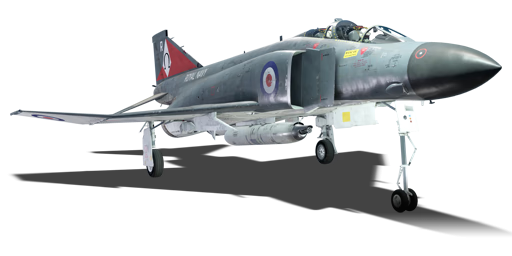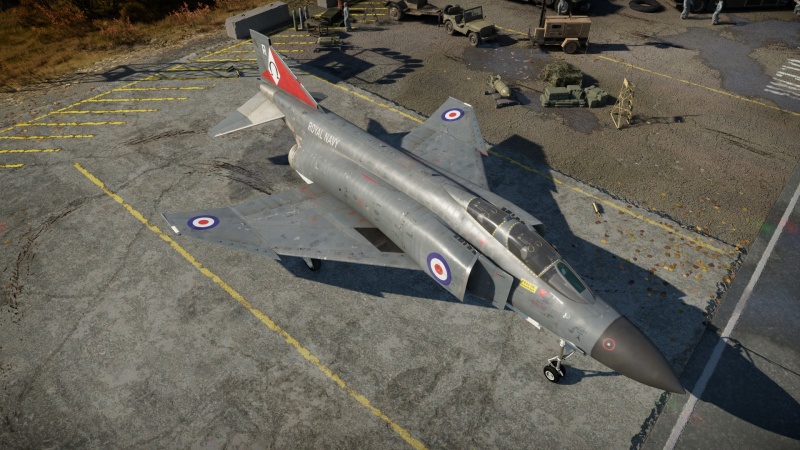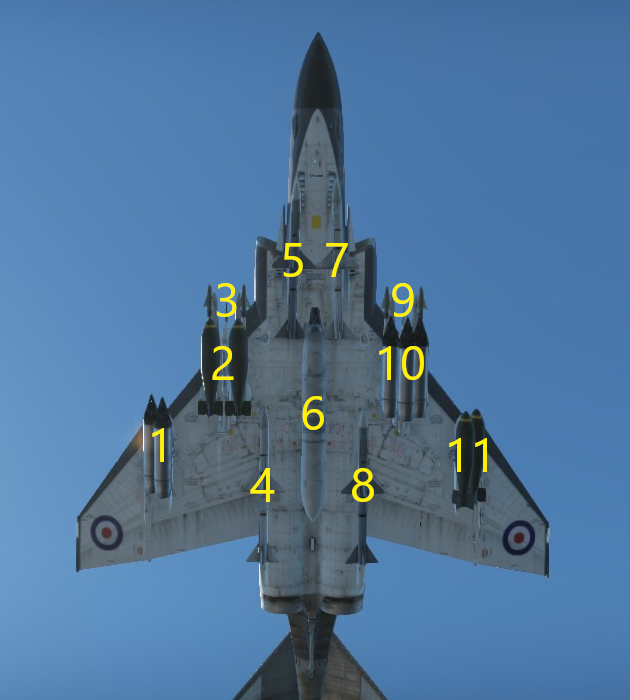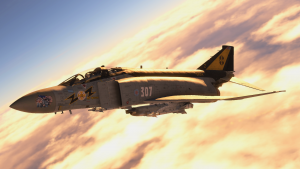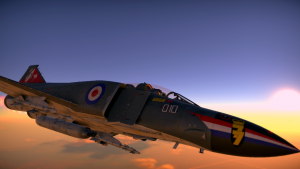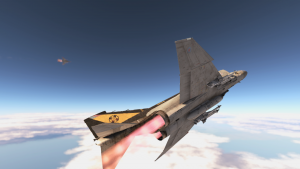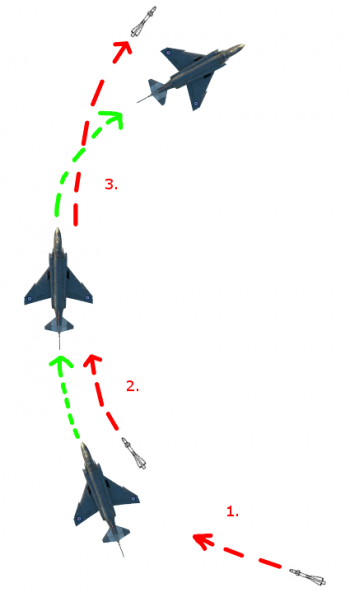Phantom FG.1
| This page is about the British jet fighter Phantom FG.1. For other versions, see F-4 Phantom II (Family). |
Contents
Description
The Phantom FG.1, otherwise known as the F-4K, is a rank VII British jet fighter with a battle rating of 11.7 (AB), 12.0 (RB), and 11.3 (SB). It was introduced in Update "Starfighters". Like the other British Spey Phantom, the Phantom FGR.2, this Phantom comes with AIM-9Ds, stock RHAW, and two turbofan engines that differentiate it from other Phantoms in the game. This Phantom is the naval variant of the British Phantom FGR.2, and as such has several adaptations for use on the smaller flight decks of British Carriers, including a longer nose wheel, slotted elevators like on the F-4E, larger leading-edge flaps, a tougher undercarriage, Spey 203s with a quicker Afterburner activation time, and a slew of other upgrades that are not modeled in War Thunder, such as a folding nose radome, drooping ailerons to aid in lift, and a different radar to the FGR.2 (AN/AWG-11 as opposed to the AN/AWG-12 in the FGR, and the AN/AWG-10 in the base F-4J model). The FG.1 takes off a good deal faster than the FGR.2 thanks to the more rapid gain of afterburner thrust, higher angle of attack possible due to the extended nose wheel, and the larger flaps.
General info
Flight performance
| Characteristics | Max Speed (km/h at 10,667 m) |
Max altitude (metres) |
Turn time (seconds) |
Rate of climb (metres/second) |
Take-off run (metres) | |||
|---|---|---|---|---|---|---|---|---|
| AB | RB | AB | RB | AB | RB | |||
| Stock | 2,190 | 2,160 | 16000 | 26.5 | 26.7 | 176.2 | 165.5 | 850 |
| Upgraded | 2,355 | 2,268 | 25.5 | 26.0 | 246.6 | 210.0 | ||
Details
| Features | |||||
|---|---|---|---|---|---|
| Combat flaps | Take-off flaps | Landing flaps | Air brakes | Arrestor gear | Drogue chute |
| X | ✓ | ✓ | ✓ | ✓ | ✓ |
| Limits | ||||||
|---|---|---|---|---|---|---|
| Wings (km/h) | Gear (km/h) | Flaps (km/h) | Max Static G | |||
| Combat | Take-off | Landing | + | - | ||
| 1458 | 463 | N/A | 584 | 463 | ~11 | ~4 |
| Optimal velocities (km/h) | |||
|---|---|---|---|
| Ailerons | Rudder | Elevators | Radiator |
| < 810 | < 750 | < 700 | N/A |
Engine performance
| Engine | Aircraft mass | ||||||
|---|---|---|---|---|---|---|---|
| Engine name | Number | Basic mass | Wing loading (full fuel) | ||||
| Rolls-Royce Spey 203 | 2 | 13,705 kg | 397 kg/m2 | ||||
| Engine characteristics | Mass with fuel (no weapons load) | Max Takeoff Weight | |||||
| Weight (each) | Type | 10m fuel | 20m fuel | 30m fuel | 33m fuel | ||
| 1,860 kg | Afterburning low-bypass turbofan | 15,457 kg | 17,177 kg | 18,913 kg | 19,545 kg | 25,400 kg | |
| Maximum engine thrust @ 0 m (RB/SB) | Thrust to weight ratio @ 0 m (WEP) | ||||||
| Condition | 100% | WEP | 10m fuel | 20m fuel | 30m fuel | 33m fuel | MTOW |
| Stationary | 5,110 kgf | 9,014 kgf | 1.17 | 1.05 | 0.95 | 0.92 | 0.71 |
| Optimal | 5,110 kgf (0 km/h) |
10,311 kgf (1,200 km/h) |
1.33 | 1.20 | 1.09 | 1.06 | 0.81 |
The radiator can be manually controlled for increased time with afterburner without the engines overheating.
Survivability and armour
The Phantom FG.1 has no armour protection, the fuel tanks are self-sealing. The crew members are located towards the front of the fuselage, and all the important modules (engines, fuel tanks) are located in the rear of the fuselage. There are also fuel tanks in the wings. These factors make the pilots well protected from the rear, but vulnerable to the front, whereas all important modules are extremely vulnerable from the rear.
- No armour protection
- Self-sealing fuel tanks
Modifications and economy
Flares should be one of your top priorities, as well as the 1000 LB bomb upgrade. These give you a fighting chance against your missile-armed opponents, and the bombs provide a relatively reliable source of RP ![]() as you work towards better equipping the aircraft for dogfights later down the line. Compressor and Engine provide the single largest addition to performance, far more than any of the other upgrades, and should be prioritised. The Airframe and Cover are not priorities, but New Boosters help immensely with taking on trickier opponents. The Offensive 20 mm and New 20 mm cannon upgrades are not priorities, as the M61 is more accurate than one would think, and with a cyclic fire rate of 6,000 rounds per minute, belt composition simply does not matter.
as you work towards better equipping the aircraft for dogfights later down the line. Compressor and Engine provide the single largest addition to performance, far more than any of the other upgrades, and should be prioritised. The Airframe and Cover are not priorities, but New Boosters help immensely with taking on trickier opponents. The Offensive 20 mm and New 20 mm cannon upgrades are not priorities, as the M61 is more accurate than one would think, and with a cyclic fire rate of 6,000 rounds per minute, belt composition simply does not matter.
Armaments
| Ballistic Computer | |||
|---|---|---|---|
| CCIP (Guns) | CCIP (Rockets) | CCIP (Bombs) | CCRP (Bombs) |
| |
|
|
|
Offensive armament
The Phantom FG.1 is armed with:
- A choice between two presets:
- Without offensive armament
- 90 x countermeasures
Suspended armament
The Phantom FG.1 can be outfitted with the following ordnance presets:
- 1 x 20 mm GAU-4 cannon (1,200 rpg)
- 2 x AIM-9D Sidewinder missiles
- 4 x AIM-9D Sidewinder missiles
- 4 x AIM-9G Sidewinder missiles
- 4 x AIM-7E Sparrow missiles
- 4 x Skyflash missiles
- 234 x SNEB type 23 rockets
- 11 x 1,000 lb H.E. M.C. Mk.13 bombs (11,000 lb total)
Custom loadout options
| 1 | 2 | 3 | 4 | 5 | 6 | 7 | 8 | 9 | 10 | 11 | ||
|---|---|---|---|---|---|---|---|---|---|---|---|---|
| 20 mm GAU-4 cannons (1200 rpg) | 1 | |||||||||||
| 1,000 lb H.E. M.C. Mk.13 bombs | 2 | 2 | 3 | 2 | 2 | |||||||
| SNEB type 23 rockets | 36 | 54 | 54 | 54 | 36 | |||||||
| AIM-7E Sparrow missiles | 1 | 1 | 1 | 1 | ||||||||
| AIM-9D Sidewinder missiles | 1, 2 | 1, 2 | ||||||||||
| AIM-9G Sidewinder missiles | 2 | 2 | ||||||||||
| Skyflash missiles | 1 | 1 | 1 | 1 | ||||||||
| Maximum permissible weight imbalance: 1,500 kg | ||||||||||||
Usage in battles
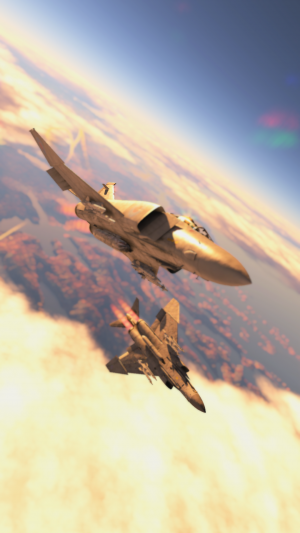
The F-4K/Phantom FG.1 is the ultimate energy fighter- its advantages over other aircraft are sheer power, roll rate, its ability to climb to high altitudes, and its nearly unparalleled speed and thrust-to-weight ratio down low are only rivaled by the MiG-21SMT. The twin Rolls-Royce Spey 203 engines produce just over 9,000 kgf thrust when you are stationary- that is to say, on the runway- and over 10,000 kgf when you're travelling at near-supersonic speeds.
Side-climb high- around 8,000-9,000 m will do- and attack those beneath you. The Phantom's fantastic climb rate, as well as the FG.1's faster acceleration to maximum speed than any other F-4, including the FGR.2, gives it an excellent climb advantage over any and all opposition up to around 5,000 m (16,500 ft), and with side-climbing can easily manage to get to 10,000 m (33,000 ft) before anybody else can, save for F-4Es. It must be noted however that the Phantom's high-altitude controllability is not very good, and the aircraft flies like a brick above 7,500 m (24,000 ft).
The Phantom also has an RWR that can also differentiate between simple radar pings and a radar lock, which is invaluable in deciding whether one needs to start evasive manoeuvres to try break the lock or whether it is simply a sign of a distant enemy contact. The RWR is particularly useful when "notching" against an enemy Pulse Doppler radar. Use the UI to bring the radar lock warning line to the side of your aircraft (90 degree off the nose/tail). This will place the Phantom in zero relative velocity to the enemy and the ground clutter thus rendering you "invisible" to their radar.
The Ferranti AN/AWG-11 Radar can scan up to 370 km away in a 120 degree arc, but generally you should keep the radar scanning in a 120 degree search pattern for targets at 18.5 km away from you. The radar also has an Air Combat Mode, or ACM mode, that shortens the radar search to an 11-by-11 degree search pattern with a maximum range of 9.25 km. In this mode, it will lock on the first target that it manages to detect and will not stop tracking nor switch to another target until the lock is lost, which can be a useful tool for detecting and tracking targets that are not visible due to clouds, distance, or other such factors.
The AIM-9D/AIM-9Gs do excellently when launched from 2.3-5.5 km (1.5-2.5 miles) away, but not up close. They are superior to the AIM-9E, with 18 Gs of maximum overload as opposed to 10 Gs, but they are still inferior to the R-60/AA-8 Aphid (30G) and the AIM-9J (20G). However, it is of note that the AIM-9D/G's seeker head is able to lock on and maintain a lock at much longer distances than either missile. It is possible to kill aircraft from 8-10 km away given the right conditions and a bit of luck.
Any British Phantom should not be taken close to the beginning furball. All mentioned facts combined give the image of a long-range missile-hauler with a licence to kill from long range given by Her Majesty Queen Elizabeth II herself. This is indeed the case. British Phantoms perform admirably in a support role in a furball, killing tailsitting MiGs, Mirages and Phantoms, as well as taking out enemy aircraft who go high to try to attack aircraft with an energy advantage, and enemy aircraft extending away from the furball to make another pass.This, however, does not mean that the Phantom FG.1 cannot handle itself in a dogfight. The FG.1 is more than capable of engaging aircraft up close (between 0-1.5 km away), with a powerful M61 Vulcan. You can easily kill aircraft in a head-on, but that doesn't mean that you should commit and stay there! Always break off if you see enemy tracer, or at the very least when the enemy aircraft is 1 km away, lest you would like your own example of the World's Best Distributor of MiG Parts spread all over the sky. When using the Vulcan, one has two options on how to engage, one of which is more risky than the other, and depends on your aircraft being spaded.
- The first method of engagement is a fairly standard low-risk hit-and-run pass. Approach the enemy, shoot, and break off. There's nothing too special about it, and it relies more on the Phantom's blinding speed to get into the target area, the Vulcan's overwhelming Burst Mass to put at least a few rounds on the target, and then get out of the danger zone as soon as possible lest you become the target of unwanted attention. It requires little in the way of skill and little in the way of performance upgrades, as the FG.1 already has considerable engine power. However, it does not allow for sustained time on target and gives you only a small window of opportunity to make the shot.
- The second method of engagement is much more risky, more rewarding, and requires a fair amount of pilot skill and a fully upgraded plane. In addition, this method is specific to British Phantoms, if not the FG.1 in general, as the FG.1 is the only Phantom which has this type of afterburner performance. Pilots are not recommended to try this in the F-4C, F-4E or F-4EJ. Conversely, this tactic works very effectively against turning non-Spey phantoms. This method should not be used above 5,000 m under any circumstances. This method works best while in cloud and with an ACM lock on the enemy. The Phantom has its best roll performance at 700-950 km/h (380-515 kts) and can use its takeoff flaps below 700 km/h without risking them ripping off. You can use the airbrakes to slow the aircraft to the required speed, and then by tapping the flaps from raised to takeoff position, you can turn a little tighter than usual, and then use your outstanding afterburner performance to rapidly regain speed. You can out-accelerate any phantom in-game below 5,000 m, and even from a slower start you can rapidly close the gap. This manoeuvre can also be attempted at an angle to the horizontal, although speed can become a much greater concern (both flap rip speed and stall speeds). While this tactic may at first seem illogical- speed, after all, is the lifeblood of jet battles- the fast afterburner acceleration of the Spey Phantom can often ensure that you do not end up stalling. This tactic is, however, highly situational and requires a fair bit of situational awareness and pilot skill to pull off. Phantom neophytes shouldn't attempt this until they have at least spaded it and grown comfortable with it.
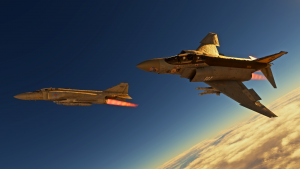
Dodging Missiles: The Do's and Don'ts
The Phantom FG.1 is slightly more manoeuvrable than the FGR.2 due to aerodynamic modifications to allow it to perform better at speeds. This means it has a slightly easier time dodging missiles. However, the easiest to avoid missiles is to not let the enemy get the opportunity to launch them at all. Keep your tail pointed away from enemy radars and the front of enemies. Utilize oblique angles and the Phantom's blinding speed and unrivalled acceleration to get out of missile lock range, and use head-on passes to avoid IRM locks on targets you wish to get gun kills on, before extending out quickly with full afterburner. Do not stay still for prolonged periods of time without checking behind you for tell-tale white streaks or the missile markers. In addition, don't let MiG-21s get close to you. Fly at an oblique angle to them (but keep your tailplane out of clear sight!) until you reach 2.5 km. The R60s, while having a lock range of 3.5 km, have an effective range of around 2.5 km, making them almost useless at longer ranges (unlike the AIM-9D/AIM-9Gs, which are most effective when at long range, and manoeuvres when seen from a distance mean smaller course corrections). Matra Magics are harder to evade using distance, but a similar rule applies, where having at least 3-5 km between you and the enemy and travelling at an angle that obscures your engines from enemy aircraft helps massively in avoiding missile launches. Manoeuvring and flares should be an absolute last resort. Pre-emptive manoeuvring to deprive the enemy of chances to lock is the first and foremost way to avoid getting blown out of the sky.
If you need to manoeuvre, though, remember to turn off the afterburner. The Afterburner provides a large beacon-like heat signature that any IRM can track with a modicum of ease. Break into a missile while popping flares. Press your flare button at least three times to release a sufficient amount to decoy off the enemy missile.
Breaking into a missile
This situation assumes that you are in a Phantom FG.1, and have been locked on and launched at by an enemy aircraft from around 1.5-2.4 km with a missile.
- A missile is launched from the left of the Phantom, which is turning to the left. The Phantom pilot sees this, and switches off the afterburner in order to reduce heat signature.
- The missile is closing rapidly and is around 1 km away. The Phantom turns inwards towards the missile to increase the amount of Gs which the missile must pull, while popping flares (6-8) in an attempt to decoy off the missile.
- The missile cannot pull the necessary Gs, and it misses. The Phantom escapes.
If dodging SAMs at low altitude during Ground Battles matches, try to put terrain features such as trees, buildings and cliffs between you and the missile to force the radar to break a lock, and break towards the missile in order to increase the G-force it needs to pull. While you can do this to some extent in Air RB, there aren't often many terrain features to begin with, and missiles are usually IRMs, which means that they don't require the launcher to continuously maintain line-of-sight with the target they launched at. Another method to dodge missiles is a barrel roll while popping flares, executed at the last possible moment, while the missile is below 1 km away. This method, while risky, is sometimes the only way you can evade close-range missiles such as the Hunter F.6's SRAAMs, the MiG-21MF and MiG-21SMT's R-60s and the Mirage IIIC's R550 Magics, as well as helicopter-mounted IRMs such as the 9M39 Igla on Russian helicopters, the AIM-92 Stinger on US helicopters, the British Starstreak, and the Mistral on French, German, and Italian helicopters.
Pros and cons
Pros:
- Great top speed, one of the fastest aircraft in the game
- Decent instantaneous manoeuvrability for a plane of its size
- Excellent engine performance at low altitude
- Excellent rate of climb
- Excellent energy retention
- Adequate selection of secondary ordnance
- Powerful M61 Vulcan with sufficient ammo can wreak havoc against enemy aircraft
- Access to pulse doppler radar and 4 Skyflash missiles, making it the second best high-altitude heavy fighter (the best being the F-4EJ KAI)
- Access to AIM-9Gs, great when engaging at about 3 km.
Cons:
- As with most jets, tends to bleed off energy in sustained turns- less so than the other top tiers but still significant enough to be worth mentioning
- Worst sustain turning performance out of any top tier jet
- Large target for cannons
- Limited payload options compared to American Phantoms
- Engines lose their edge at higher altitudes compared to US turbojets
- Control authority suffers drastically above ~8,000 m
- Possibility of ripping its wings in turns above 1,000 km/h
- The gunpod produces a noticeable amount of drag
History
Background
From the late 1950s onwards the British Government began looking to replace a number of its early second-generation jet aircraft. The RAF was looking to replace the English Electric Canberra in the long-range interdictor role, and the Hawker Hunter in the close air support role; meanwhile the Royal Navy was looking to replace their de Havilland Sea Vixens in the fleet air defence role[1]. Two aircraft programs were started to produce suitable replacements; the BAC TSR-2 was to be a highly advanced strike and reconnaissance aircraft to replace the Canberra. Meanwhile the Hunter and the Sea Vixen would be replaced by different versions of the P.1154; a Mach 2 capable VTOL aircraft developed from the P.1127 (the predecessor of famous Harrier Jump Jet). The Navy were not entirely happy with the idea of the navalised P.1154, believing that it did not suit their needs; and in 1964 they dropped out of the programme, deciding to purchase the F-4 Phantom from America instead. In the same year a new government was elected and in 1965 cancelled both the TSR-2 and P.1154 programmes on cost grounds, leaving the RAF without its much needed Canberra and Hunter replacements. The Government announced a plan to purchase the F-111K from America to replace the TSR-2 program (the F-111K would also eventually be cancelled on grounds of cost), while the Hunter would be replaced by F-4 Phantom from America[2].
Development
Both the Royal Navy and RAF were now set to purchase the F-4 Phantom. The RAF could have operated standard F-4 Phantoms (and to some extent would have preferred to)[2], however the aircraft was going to need modifications in order to be able to operate off of the UK's aircraft carriers, which were smaller than the ones Phantoms usually operated from. In a bid to help the British aviation industry (which had been hurt by a number of cancelled programmes), and make the aircraft suitable for use by the Royal Navy it was agreed that all UK Phantoms would be significantly modified, by British companies, from their US counterparts. The most notable change would be the replacement of the American J79 turbojet engines with larger and more powerful Rolls-Royce Spey turbofans; a modified rear fuselage to accommodate the new engines would also be built by BAC, and the aircraft's radar system would be built under license by Ferranti[1].
It was decided that the UK Phantoms would be based off of the F-4J, which was then the primary version in service with the US Navy at the time[1]. As the RAF and Royal Navy had differing requirements it was decided that two variants of the UK Phantom would be designed: the first variant, for the Royal Navy, would be designated F-4K or Phantom FG.1; while the RAF variant would be developed from the navy variant and be designated F-4M or Phantom FGR.2. Work began on modifying the F-4J to meet the Royal Navy's needs; the nose radome had to be made to hinge 180 degreed, to allow the Phantom fit on the smaller deck elevators of British carriers, and a telescopic nose gear was installed to allow the aircraft to sit pitched nose-up on the flight deck (by up to 11°), reducing take-off distance[1]. The new engines were installed at a slight downwards angle to further increase take-off performance and the rear fuselage to be redesigned to both accommodate the new engines and cope with the increased heat they produced; the air intakes also had to be made larger, and additional intake doors added in the fuselage to provide the Speys with the airflow they required[2]. Many other small changes were also made to UK Phantoms. The first F-4K prototype flew on 27 June 1966, with the First F-4M prototype flying on 17 February 1967.
Service
The first F-4Ks were delivered in April 1968 and were designated Phantom FG.1, early the following year they began test flights from HMS Eagle and the USS Saratoga. During the testing the intense heat produced by the downward-angled Spey engines, while the afterburner was engaged, caused the flight deck plating of the USS Saratoga to buckle[2]. On-board HMS Eagle heavy-duty steel plating had to be welded to the flight deck; and be cooled using water from the ship's fire hoses between flights, in order to stop it from melting[3]. When the HMS Ark Royal was upgraded to operate Phantoms it had to have water-cooled blast deflectors and decking installed to prevent the Phantom's engines from damaging the flight deck [2]. HMS Ark Royal had finished its refit in 1970, by which point the refit of HMS Eagle had been cancelled, along with plans to build two additional aircraft carriers. With the Navy now only having one carrier capable of operating Phantoms it was decided to reduce the Navy's Phantom fleet down to 28 aircraft, with the other 20 FG.1s being transferred to the RAF. The remaining Royal Navy Phantoms would serve on the HMS Ark Royal (R09) until her retirement.
The first F-4Ms entered RAF service in May 1969, filling the role of tactical strike aircraft; they were given the designation Phantom FGR.2 (with FGR standing for Fighter/Ground attack/Reconnaissance). The RAF's Phantom FGR.2 was overall very similar to the Navy's FG.1 variant, but had a number of changes; they used a slightly different version of Spey engines (the FG.1 had faster afterburner engagement to aid with aborted landings on aircraft carriers), and naval features like the telescopic nose gear, slotted tail, and cockpit-controlled wing folding were dropped. The FGR.2 also had different avionics, the radar was slightly different and additional functionality such as an inertial navigation / attack system was added, as well as modification needed to allow the FGR.2 to use a gun pod and reconnaissance pod, among other changes[4]. Both the FGR.2 and FG.1 would later be modified with squared off tails, holding a radar warning receiver.
The Phantom FG.1s were withdrawn from Royal Navy service in 1978, with the decommissioning of HMS Ark Royal, and were transferred to the RAF to serve in air defence roles. The Phantom FG.1 was not originally equipped to carry a gun pod while in Royal Navy service, following their transfer to RAF service they were modified in order to carry the SUU-23/A 20 mm gun pod (the same one used by the RAF Phantom FGR.2s). The Phantoms were replaced in Navy service by the Harrier Jump Jet, which was able to operate from the Navy's new Invincible-class aircraft carriers (which were smaller than the HMS Ark Royal).
Following the Falklands War in 1982 the UK deployed a Squadron of FGR.2s to defend the Falkland Islands from any future attack; however this left a gap in the Air defence of the UK Mainland. It was decided to purchase 15 more F-4Js from America to fill this gap. The F4-Js were upgraded to F-4S standard and entered service with the RAF on 19 October 1984 under the designation Phantom F.3 or F-4J(UK)[2]. The Phantom remained the UK's primary Air defence aircraft until it was gradually replaced by the Panavia Tornado; the last FG.1s retired on 30 January 1990, the last F.3s retired on 31 January 1991, and the FGR.2 left RAF service on 1 November 1992. The FGR.2 was due to retire earlier however just before retirement it was called back into service to defend RAF Akrotiri, on Cyprus, during the First Gulf War[2].
A total of 48 Phantom FG.1s, 118 Phantom FGR.2s and 15 Phantom F.3s were built[1].
Further development plans
Prior to the Phantom's retirement from RAF service there had been a plan to retrofit them with an upgraded version of the Spey engine. A program was started to design the new engines; they would have various improvements, the most notable of which being new turbine blades, reportedly manufactured from a single metal crystal[5]. These blades would increase the operating life of the engines under normal conditions, but also give the option of operating the engines at higher temperatures, and thus higher thrust (although this would come at the expense of reduced engine life). These engines were known as Spey 205s and had a maximum thrust of 25,000 lb (11,340 kgf)[5], compared to 20,515 lb (9,305 kgf) for the regular Spey engines; although it is unclear if they would be used at this thrust rating while in service. With the Phantom retired the Spey 205 programme was cancelled, and no engines were produced under the Spey 205 name; however 12 Spey 202 engines had been upgraded to Spey 205 standard for testing (and are now generally referred to as Spey 205s, or Spey 202 hybrids)[6]. It is known that after the programme was cancelled two of the Spey 205 prototypes, along with two standard Spey 202s were obtained by the ThrustSSC programme (the world's fastest car)[5], although reports vary on whether the car was fitted with Spey 202s or 205s when it completed its record-breaking run.
Comparison with American Phantoms
The Rolls-Royce Spey engines gave British Phantoms notably different performance to their American counterparts. At low altitude British Phantoms accelerated faster than standard F-4Js and had a higher top speed; it was estimated that they had a 30% shorter take-off distance and a 20% faster climb to altitude[1]. The Spey turbofan engines were also more fuel efficient than the J-79 turbojets, giving British Phantoms a 10 - 15 % increase in range compared to American aircraft[4]. The main drawback of the British design was that the reshaped fuselage produced more drag than the original design, meaning that at high altitude British Phantoms were slower and performed worse than their American counterparts (British Phantoms topped out at about Mach 1.9 at altitude, while American Phantoms could reach Mach 2.1)[2].
Media
- Skins
- Videos
See also
- Aircraft of comparable role, configuration and era
- Mikoyan-Gurevich MiG-21
- SAAB J35D Draken
- Dassault Mirage IIIC
External links
- [Wikipedia] McDonnell Douglas Phantom in UK service
- [Thunder and Lightnings] McDonnell-Douglas/BAC F-4K/M Phantom II
Citations
Bibliography
- Bourne, Nigel. (1997). Development of the Rolls-Royce Military Spey Mk202 Engine. Retrieved from ThrustSSC
- Burke, Damien. (2016). McDonnell-Douglas/BAC F-4K/M Phantom II. Retrieved from Thunder and Lightnings
- Gledhill, David. (2017). Phantom in the Cold War: RAF Wildenrath 1977 - 1992. Barnsley: Pen & Sword Aviation.
- Searles, Dick. (n.d.). HMS Eagle Deck Trials 1969. Retrieved from Phantom F4K - Fleet Air Arm Royal Navy
- SSC Programme Ltd. (1997). The Story of the Rolls-Royce Spey. Retrieved from ThrustSSC
- Wikipedia. (n.d.). McDonnell Douglas Phantom in UK service. Retrieved from Wikipedia
| McDonnell Aircraft Corporation | |
|---|---|
| Jet Fighters | F2H-2 · F3H-2 |
| F-4C Phantom II · F-4E Phantom II · F-4J Phantom II · F-4S Phantom II | |
| F-15A · F-15C MSIP II · F-15E | |
| Strike Aircraft | AV-8B Plus · AV-8B (NA) |
| Helicopters | AH-6M |
| Export/Licensed | |
| Aircraft | ◄F-4F Early · ◄F-4F · ◄F-4F KWS LV · Phantom FG.1 · Phantom FGR.2 · F-4J(UK) Phantom II · F-4EJ Phantom II · F-4EJ ADTW · Kurnass · Kurnass 2000 |
| F-15J · F-15J(M) · Baz · Baz Meshupar · F-15I Ra’am | |
| ▄AV-8B Plus | |
| Helicopters | Lahatut |
| The McDonnell Aircraft Corporation merged with Douglas Aircraft Company in 1967 to form McDonnell Douglas Corporation. Later it was merged with The Boeing Company in 1997. | |
| See Also | Mitsubishi Heavy Industries |
| Britain jet aircraft | |
|---|---|
| Blackburn | Buccaneer S.1 · Buccaneer S.2 · Buccaneer S.2B |
| British Aerospace | Harrier GR.7 · Sea Harrier FRS.1 (e) · Sea Harrier FRS.1 · Sea Harrier FA 2 |
| British Aircraft Corporation | Strikemaster Mk.88 |
| English Electric | Canberra B Mk 2 · Canberra B (I) Mk 6 · Lightning F.6 · Lightning F.53 |
| Gloster | Meteor F Mk 3 · Sea Meteor F Mk 3 · Meteor F Mk 4 G.41F · Meteor F Mk 4 G.41G · Meteor F Mk 8 G.41K · Meteor F Mk.8 Reaper |
| Javelin F.(A.W.) Mk.9 | |
| de Havilland | Vampire F.B.5 · Venom FB.4 · Sea Venom FAW 20 · Sea Vixen F.A.W. Mk.2 |
| Hawker | Sea Hawk FGA.6 · Hunter F.1 · Hunter F.6 · Hunter FGA.9 · Harrier GR.1 · Harrier GR.3 |
| Panavia | Tornado GR.1 · Tornado GR.4 · Tornado F.3 · Tornado F.3 Late |
| SEPECAT | Jaguar GR.1 · Jaguar GR.1A · Jaguar IS |
| Supermarine | Attacker FB 1 · Attacker FB.2 · Scimitar F Mk.1 · Swift F.1 · Swift F.7 |
| Foreign | Phantom FG.1 (USA) · Phantom FGR.2 (USA) · F-4J(UK) Phantom II (USA) |
| Australia | F-111C |
| India | ▄MiG-21 Bison |
| South Africa | ▄JAS39C |


